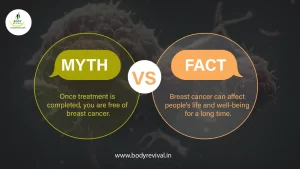Breast cancer is one of the more well-known and discussed cancers, but many misconceptions exist.
Unless people have had breast cancer or are close to someone who has, they may be unable to distinguish between myth and fact about breast cancer and how does breast cancer affect women’s lives!
True, breast cancer is one of the more well-known and discussed cancers, yet many misconceptions exist. While these myths may look harmless when spreading awareness, people don’t believe in factual information. This leads to more harm than good!
Here are five common breast cancer myths that you should be aware of!
1) MYTH: Once treatment is completed, you are free of breast cancer.
FACT: Breast cancer can affect people’s life and well-being for a long time.

People with breast cancer frequently report that their family and friends expect them to be ready to move on once treatments, like immunotherapy surgery, are completed. In actuality, targeted therapy like Herceptin (chemical name: trastuzumab) can be given for a year or more. Tamoxifen and aromatase inhibitors, for example, are frequently recommended for up to ten years.
If a woman decides to have her breasts reconstructed, she may need several procedures over several months. Those with metastatic or stage IV breast cancer will be treated for the remainder of their lives.
Treatment side effects can cause discomfort, fatigue, skin changes, neuropathy, menopausal symptoms, and others, depending on the plan. Other mental and emotional adverse effects include worrying, fear of recurrence, and relationship changes. Many people’s breast cancer experiences linger for years — even for life, in the case of metastatic breast cancer — but their loved ones don’t understand.
Get Free Consultation
2) MYTH: Breast cancer always causes a noticeable lump.
FACT: Breast cancer does not always cause a lump, especially when it first appears.
Some believe breast cancer always results in a lump that can be felt during a self-exam. They may use this as an excuse to avoid mammograms, believing they can detect any changes that may suggest a concern.
Breast cancer, on the other hand, does not necessarily cause a lump. Cancer may have spread beyond the breast and into the lymph nodes by then. Although performing breast self-exams is a good idea, it is not a replacement for routine mammography screening.
Other myths of breast cancer and what types of breast lumps are less concerning include – “If the lump is uncomfortable, it isn’t breast cancer” and “If you can feel a smooth and moving lump under the skin, it isn’t breast cancer.”
A healthcare expert should examine any lump or odd mass that may be felt through the skin. Although most lumps are benign (non-cancerous), breast cancer is always a potential.
3) MYTH: Annual mammograms ensure that breast cancer is detected early.
FACT: Although mammography is the most effective early detection method available, it does not always detect breast cancer at an early stage.
It’s natural to exhale a sigh of relief when your mammogram returns negative. Most women believe they are “fine for another year” and dismiss breast cancer.
Although mammography is an excellent screening technique, it has its challenges. It can produce a false-negative result, meaning that the images appear normal despite cancerous cells being present.
Mammograms are predicted to miss roughly 20% of breast cancers during screening. False-negative breast cancer results are more likely in women with thick breast tissue composed of epithelial and connective tissue rather than fatty tissue. Breast density is found to be higher in younger women.
The truth about false negatives explains why a woman can have normal mammography and be diagnosed with breast cancer a few months later. Even after a series of normal mammograms, some women are identified with advanced breast cancer. In addition, breast cancer can form and spread swiftly in a year or two following true negative mammography.
However, mammography detects most breast cancers, so regular screenings are important. It is also necessary to monitor any changes in your breasts, undertake monthly breast self-exams, and get a physical examination by a health expert once a year.
4) MYTH: Using underarm deodorant can lead to breast cancer.
FACT: There is no evidence of a link between underarm antiperspirants and breast cancer.
There have always been myths that antiperspirants with aluminum and other chemicals increase breast cancer risk. Shaving the underarms was considered to worsen the problem by generating tiny nicks that allow more toxins into the body.
Another notion was that antiperspirants, by preventing underarm sweating, could limit the release of hazardous chemicals from the underarm lymph nodes, raising the risk of cancer.
However, there is no evidence that antiperspirant use causes breast cancer. Nonetheless, some studies have discovered that women who use aluminum items beneath their arms are likelier to have greater aluminum contents in breast tissue.
5) MYTH: Excessive sugar consumption causes breast cancer.
FACT: There is no proof consuming sugar causes breast cancer.
There is a widespread misconception that sugar can feed cancer and accelerate its growth, not just in breast cancer but all cancer types. All cells, malignant or healthy, require glucose (the sugar in the blood) as fuel. While cancer cells eat sugar faster than normal cells, there is no proof that excessive sugar consumption causes cancer.
Desserts, sweets, cakes, sweetened beverages, and sugar-containing processed foods should all be avoided for health reasons. Reading labels is necessary since many items include “hidden” added sugars such as high-fructose corn syrup.
Takeaways
Breast cancer is a disease that has been surrounded by many misconceptions over the years. But, we must differentiate between truth and fiction. The only way to do this is by relying on accurate information. Only by combating myths can we prevent and treat them effectively.
Let’s make sure we arm ourselves with the right knowledge and continue to educate ourselves and others around us.